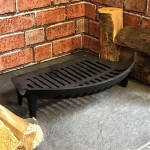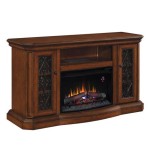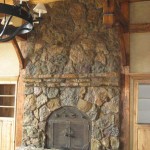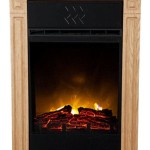The Enduring Appeal of a Distressed White Wood Fireplace
A fireplace serves as a focal point within a living space, offering both aesthetic appeal and functional warmth. Among the various styles and materials available, the distressed white wood fireplace has experienced a surge in popularity, largely due to its ability to blend seamlessly with diverse design aesthetics while imbuing a sense of timeless elegance. This article explores the nuances of distressed white wood fireplaces, examining their stylistic versatility, the methods used to achieve the distressed effect, their suitability for various interior designs, and the maintenance considerations required to preserve their unique charm.
The term "distressed" in interior design refers to a technique that deliberately ages or weathers a surface to create an antique or rustic appearance. This is often achieved by applying various techniques that mimic the effects of time and use, such as scratching, sanding, staining, and the application of layered paints. When applied to a fireplace, the distressed white wood finish offers a unique combination of rustic charm and refined elegance. The white color provides a clean, bright backdrop, while the distressed elements add character and depth, preventing the fireplace from appearing overly sterile or modern.
Stylistic Versatility and Compatibility
One of the key advantages of a distressed white wood fireplace is its adaptability to a wide range of interior design styles. While it might appear most naturally suited for farmhouse or cottage-style homes, its versatility extends far beyond these specific aesthetics.
In a farmhouse setting, a distressed white wood fireplace complements the overall rustic charm, harmonizing with elements like natural wood floors, exposed beams, and vintage furniture. The distressed finish reinforces the sense of history and lived-in comfort typical of farmhouse design. The white paint keeps the space light and airy, preventing it from feeling too heavy or dark.
For a cottage-style interior, the distressed white wood fireplace adds a touch of romanticism and whimsy. It pairs well with soft pastel colors, floral patterns, and delicate fabrics. The distressed finish contributes to the overall feeling of cozy imperfection, creating an inviting and relaxing atmosphere.
Even in more modern or contemporary spaces, a distressed white wood fireplace can serve as a striking contrast, introducing an element of warmth and texture to an otherwise sleek and minimalist environment. When incorporated into a modern design, it's often paired with clean lines, neutral colors, and carefully curated accessories to create a balanced and visually appealing composition. The distressed finish prevents the fireplace from appearing too stark or impersonal, adding a layer of depth and visual interest.
Furthermore, the distressed white wood fireplace can be effectively integrated into transitional designs, which blend traditional and contemporary elements. In this context, it acts as a bridge between the two styles, offering a sense of familiarity and comfort while still maintaining a contemporary edge. The subtle imperfections of the distressed finish soften the sharp lines often found in modern design, while the white color keeps the space feeling fresh and updated.
The ability of a distressed white wood fireplace to complement such a diverse range of styles makes it a popular choice for homeowners seeking a versatile and timeless design element. Its neutrality allows it to adapt to changing trends and personal preferences, ensuring its enduring appeal for years to come.
Techniques for Achieving the Distressed White Finish
There are several techniques used to create the distressed white wood finish on a fireplace. These methods vary in complexity and the specific effects they produce, allowing for a wide range of customization and personalization.
One common technique involves sanding down the edges and corners of the wood after it has been painted white. This reveals the underlying wood grain or previous layers of paint, creating a worn and aged appearance. The amount of sanding can be adjusted to achieve the desired level of distress, from subtle wear to a more pronounced and rustic effect.
Another method involves layering different shades of white or off-white paint. By applying multiple coats of paint and then selectively sanding or scraping away certain areas, a multi-dimensional and textured finish can be achieved. This technique adds depth and visual interest to the fireplace, making it appear as though it has been exposed to the elements and gradually aged over time.
Crackling is another technique that is often used to create a distressed finish. This involves applying a crackle medium between layers of paint, causing the top layer to crack and reveal the underlying layer. This creates a network of fine cracks that resemble the aged and weathered surface of antique furniture. The size and density of the cracks can be controlled by adjusting the type and amount of crackle medium used.
Dry brushing is a technique that uses a dry brush with a small amount of paint to lightly brush over the surface of the wood. This creates a subtle and textured effect, highlighting the grain and adding a sense of movement to the finish. Dry brushing is often used to accentuate the distressed areas of the fireplace, adding further depth and dimension.
In addition to these techniques, various tools can be used to create specific distressed effects. Chains, hammers, and other implements can be used to create dents, scratches, and other imperfections in the wood surface. These imperfections are then highlighted by the white paint, adding to the overall rustic and aged appearance.
The choice of technique depends on the desired aesthetic and the skill level of the individual applying the finish. Some techniques are relatively simple and straightforward, while others require more expertise and attention to detail. Regardless of the technique used, the goal is to create a visually appealing and authentic-looking distressed finish that enhances the character and charm of the fireplace.
Maintenance Considerations for Distressed White Wood Fireplaces
While a distressed white wood fireplace is aesthetically pleasing, proper maintenance is crucial to preserving its beauty and ensuring its longevity. The distressed finish, by its very nature, is more susceptible to wear and tear than a pristine, unblemished surface. Therefore, regular cleaning and occasional touch-ups are necessary to keep the fireplace looking its best.
Regular dusting is essential to prevent the buildup of dirt and grime, which can dull the white paint and obscure the distressed details. A soft cloth or brush should be used to gently dust the surface of the fireplace, paying particular attention to crevices and corners.
For more stubborn stains or spills, a mild soap and water solution can be used. However, it is important to avoid harsh chemicals or abrasive cleaners, as these can damage the paint and the wood underneath. The area should be gently cleaned with a damp cloth and then thoroughly dried to prevent water damage.
Over time, the distressed finish may become chipped or scratched, especially in high-traffic areas. To address these imperfections, touch-up paint can be used to conceal the damage. It is important to use a paint that matches the original color and sheen of the fireplace to ensure a seamless repair. Small brushes or sponges can be used to apply the touch-up paint to the affected areas, blending it in with the surrounding finish.
In addition to regular cleaning and touch-ups, it is important to protect the fireplace from excessive heat and moisture. While fireplaces are designed to withstand high temperatures, prolonged exposure to extreme heat can damage the paint and the wood. It is also important to ensure that the fireplace is properly ventilated to prevent the buildup of moisture, which can lead to mold and mildew growth.
Depending on the type of wood used for the fireplace, occasional sealing or waxing may be necessary to protect the surface from moisture and stains. This is particularly important for fireplaces that are exposed to damp or humid environments. A sealant or wax can be applied to the surface of the wood to create a protective barrier, preventing water and other liquids from penetrating the finish.
By following these maintenance guidelines, homeowners can ensure that their distressed white wood fireplace remains a beautiful and cherished focal point in their home for many years to come. The initial investment in maintenance will preserve the unique characteristics of the distressed finish and prevent the need for more extensive and costly repairs in the future.

Distressed Finish Fireplace Ana White

How To Antique A Mantle For Diy Beginners Happily Ever Adventures

Timeline Wood 11 32 In X 5 47 Distressed White Panels 6 Pack 00955 The Home Depot Brick Fireplace Makeover Paneling Shiplap Wall

Distressed Hand Hewn Fireplace Mantel Solid Wood Simply Modern Woodworks

Distressed Alder Mantel Notable Wood

Paint Fireplace Distressed

Antique Brick And White Molding Fireplace Makeover Maison De Pax

How To Antique A Mantle For Diy Beginners Happily Ever Adventures

Painted White Distressed Antique Fireplace Mantel With Detailed Mouldings Chairish

Amerlife 59 Glass Fireplace Tv Stand Fits 65 Tvs 12 Flame Colors 250 Lbs Cap Distressed White Com








